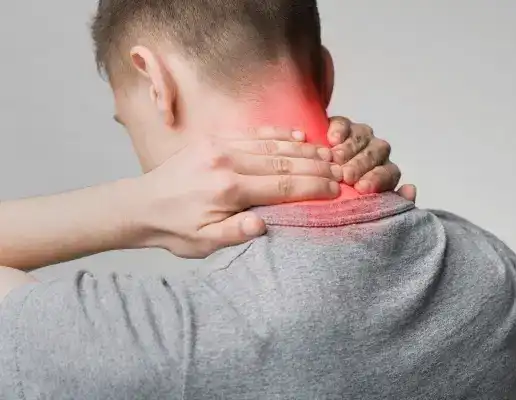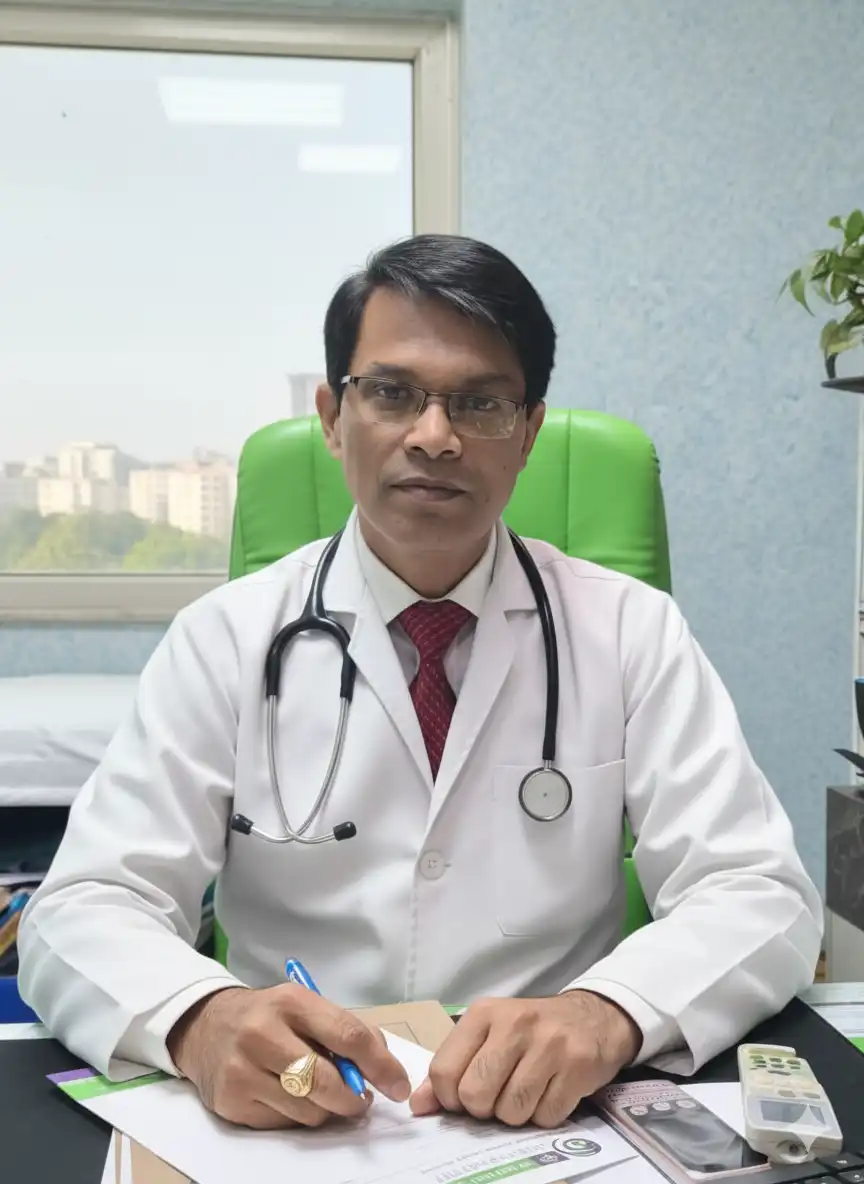
What is Cervical Spondylosis?
Cervical Spondylosis, also known as cervical osteoarthritis or neck arthritis, is a degenerative condition of the cervical spine. It is one of the most common spine disorders seen in middle-aged and elderly individuals, but increasingly, it is also affecting younger people due to changes in lifestyle and work patterns.

In today’s fast-paced, technology-driven world, many people spend long hours in front of computers or mobile screens, often with poor posture. This puts excessive strain on the neck and leads to early wear and tear of the cervical spine. Occupations that demand prolonged sitting, concentration, or repeated neck movements further increase the risk.
Cervical spondylosis may start as a minor stiffness or occasional neck pain, but if left untreated, it can lead to nerve compression, radiating pain, tingling, numbness, or weakness in arms and hands. In severe cases, it may even interfere with walking and balance.
While modern medicine usually relies on painkillers, anti-inflammatory drugs, or even surgery, these approaches only provide temporary relief and may carry side effects. Homeopathy, on the other hand, treats cervical spondylosis holistically, addressing not just the pain but the patient’s overall health, immunity, and lifestyle.
Symptoms of Cervical Spondylosis
The symptoms vary depending on the severity of degeneration and whether nerves are affected.
Common Symptoms Include:
- Persistent neck pain and stiffness
- Headache, often starting from the back of the head
- A grating or popping sound when turning the neck
- Muscle spasms in the neck and shoulders
- Pain radiating to the arms and shoulders
- Numbness, tingling, or weakness in arms, hands, and fingers (if nerve compression occurs)
- Difficulty in walking, balance problems, or weakness in legs (in advanced cases)
Causes and Risk Factors of Cervical Spondylosis
The primary cause is age-related degeneration of the vertebrae and intervertebral discs. As we age, the discs between the cervical vertebrae lose fluid, elasticity, and height, leading to stiffness and bone spur (osteophyte) formation. However, lifestyle factors have made it more common in younger people too.
Major Risk Factors:
- Ageing: Most common cause; risk increases after 40 years.
- Occupation: Desk jobs, computer professionals, or people working with prolonged concentration.
- Posture: Continuous neck bending, mobile phone overuse, or awkward sitting posture.
- Previous Injury: Any past trauma to the neck makes the spine more vulnerable.
- Genetics: Family history of spondylosis or neck pain.
- Smoking: Proven to increase risk of degenerative spinal changes.
- Stress & Anxiety: Contribute to muscle tightness, worsening pain.
Clinical Signs
- Tenderness in the posterior neck muscles
- Restricted neck movements due to spasm
- In late stages – muscle wasting in upper limbs
- Sensory and motor changes depending on nerve involvement
Diagnosis of Cervical Spondylosis
Accurate diagnosis is essential to rule out other conditions like slipped disc or nerve compression.
- X-ray of Cervical Spine (AP & Lateral View): Shows disc space narrowing, osteophytes, and loss of normal cervical curve.
- CT Scan: Provides detailed bony images, detects spondylotic ridges, and nerve root involvement.
- MRI Scan: Gold standard for soft tissue; detects herniated discs, spinal cord compression, and nerve root involvement.
General Management & Lifestyle Advice
Lifestyle modification plays a major role in both prevention and management.
General Guidelines:
- Maintain correct posture at work (straight spine, monitor at eye level).
- Avoid prolonged bending or awkward neck positions.
- Use a supportive chair and ergonomic workspace.
- Apply local heat therapy for stiffness.
- Use a cervical collar temporarily if recommended.
- Maintain a healthy body weight.
- Practice regular neck exercises to improve flexibility.
- Avoid sleeping on high pillows.
Dietary Advice:
✅ Include – Whole grains, fresh fruits, green vegetables, nuts, and seeds.
❌ Avoid – Highly refined foods, excess sugar, fried foods, and too much salt.
Prevention of Cervical Spondylosis
- Regular stretching and strengthening exercises for the neck.
- Avoid carrying heavy weights on the head or shoulders.
- Take frequent breaks during long desk jobs or driving.
- Ensure a balanced work-life routine to reduce stress.
- Quit smoking to improve spinal health.
Homeopathic Treatment for Cervical Spondylosis
Unlike conventional treatment, which only suppresses symptoms, homeopathy aims at holistic healing. Remedies are selected based on the individual’s physical symptoms, emotional state, and constitution.
Commonly Prescribed Remedies:
- Rhus Toxicodendron
- For stiffness and pain, better by movement.
- Pain is worse after rest or cold weather.
- Ideal for overuse or strain-related neck pain.
- Bryonia Alba
- For sharp, shooting pain worsened by any movement.
- Patient prefers rest and firm support.
- Associated with irritability due to pain.
- Gelsemium
- For neck pain with heaviness, weakness, or dizziness.
- Often seen after exhaustion or anxiety.
- Cimicifuga (Actaea Racemosa)
- Neck pain in women is linked to menstruation or menopause.
- Pain radiates to the shoulders and upper back.
- Associated with mood swings or anxiety.
- Kalmia Latifolia
- For nerve involvement – pain radiating to arms, tingling, or numbness.
- Suddenly, shooting pain from the neck to the hands.
- Calcarea Phosphorica
- For chronic degenerative cases.
- Useful in thin, weak, or growing individuals with weak bones.
Homoeopathic Approach at Dr. Sanjay’s Homoeopathy
At Dr. Sanjay’s Homoeopathy, treatment for cervical spondylosis is highly individualized. Unlike one-size-fits-all painkillers, homeopathy works by:
- Considering the whole patient’s physical, mental, and emotional health.
- Strengthening the vital force of the body to restore balance.
- Prescribing dynamic, diluted medicines with no side effects.
- Focusing on long-term relief and improved quality of life.
Our approach ensures that patients not only get rid of pain but also experience better immunity, flexibility, and overall health.
Why choose Dr. Sanjay’s Homoeopathy for Cervical Spondylosis (Neck Arthritis) treatment in Lucknow, India?
Dr. Sanjay’s Homoeopathy is a trusted clinic for safe and effective cervical spondylosis treatment in Lucknow, India. With years of expertise, Dr. Sanjay provides specialised cervical spondylosis homeopathic treatment in Lucknow, India that helps relieve neck pain, stiffness, tingling, dizziness, and restricted movement naturally without side effects. As a leading homeopathic doctor in Lucknow, he follows international treatment standards and offers personalised care that addresses the root cause of cervical spondylosis while strengthening spinal health. Patients choose Dr. Sanjay’s Homoeopathy for its holistic healing, long-lasting relief, and compassionate approach in managing degenerative conditions like cervical spondylosis (neck arthritis).
Patients from across the world trust Dr. Sanjay’s Homoeopathy for Cervical Spondylosis (Neck Arthritis) treatment in Lucknow, India. Dr. Sanjay Singh, who led this clinic, has successfully treated thousands of patients with Cervical Spondylosis (Neck Arthritis) Problems. This makes him the best doctor for Cervical Spondylosis or Neck Arthritis.
